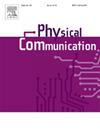Covert performance analysis in IRS-assisted RSMA systems with imperfect SIC
IF 2.2
4区 计算机科学
Q3 ENGINEERING, ELECTRICAL & ELECTRONIC
引用次数: 0
Abstract
Covert communication serves as a pivotal technology for safeguarding wireless communication security. To fortify communication security, this paper introduces a covert communication framework leveraging intelligent reflecting surface (IRS)-assisted rate-splitting multiple access (RSMA), while accounting for imperfect successive interference cancellation (SIC). RSMA operates by partitioning the intended information into common and private components, which are then transmitted through superposition coding. In this system architecture, the base station utilizes IRS to facilitate the transmission of superimposed signals to both covert and legitimate user, where the common signals and legitimate user’s private signals act as transmission cover for the covert user’s private data streams. To evaluate system performance, we derive an approximate expression of detection error probability (DEP), and then calculate the outage probability (OP) of users decode their respective signals. Finally, we maximize the system’s covert rate by balancing network reliability and covertness requirements. Simulation results reveal that imperfect SIC introduces significant performance degradation and these detrimental effects can be effectively alleviated through increasing IRS elements. Additionally, the numerical results also demonstrate that the proposed IRS-assisted RSMA scheme is superior to the conventional RSMA scheme and IRS-assisted NOMA scheme.
不完全SIC下irs辅助RSMA系统的隐蔽性能分析
隐蔽通信是保障无线通信安全的关键技术。为了加强通信安全,本文引入了一种利用智能反射面(IRS)辅助分频多址(RSMA)的隐蔽通信框架,同时考虑了不完美连续干扰抵消(SIC)。RSMA通过将预期信息划分为公共和私有组件,然后通过叠加编码传输。在该系统架构中,基站利用IRS促进叠加信号向隐蔽用户和合法用户的传输,其中公共信号和合法用户的私有信号充当隐蔽用户私有数据流的传输掩护。为了评估系统性能,我们推导了检测错误概率(DEP)的近似表达式,然后计算了用户解码各自信号的中断概率(OP)。最后,我们通过平衡网络可靠性和隐蔽性要求来最大化系统的隐蔽率。仿真结果表明,不完善的SIC会导致显著的性能下降,通过增加IRS元素可以有效地缓解这些不利影响。此外,数值结果还表明,irs辅助的RSMA方案优于传统的RSMA方案和irs辅助的NOMA方案。
本文章由计算机程序翻译,如有差异,请以英文原文为准。
求助全文
约1分钟内获得全文
求助全文
来源期刊

Physical Communication
ENGINEERING, ELECTRICAL & ELECTRONICTELECO-TELECOMMUNICATIONS
CiteScore
5.00
自引率
9.10%
发文量
212
审稿时长
55 days
期刊介绍:
PHYCOM: Physical Communication is an international and archival journal providing complete coverage of all topics of interest to those involved in all aspects of physical layer communications. Theoretical research contributions presenting new techniques, concepts or analyses, applied contributions reporting on experiences and experiments, and tutorials are published.
Topics of interest include but are not limited to:
Physical layer issues of Wireless Local Area Networks, WiMAX, Wireless Mesh Networks, Sensor and Ad Hoc Networks, PCS Systems; Radio access protocols and algorithms for the physical layer; Spread Spectrum Communications; Channel Modeling; Detection and Estimation; Modulation and Coding; Multiplexing and Carrier Techniques; Broadband Wireless Communications; Wireless Personal Communications; Multi-user Detection; Signal Separation and Interference rejection: Multimedia Communications over Wireless; DSP Applications to Wireless Systems; Experimental and Prototype Results; Multiple Access Techniques; Space-time Processing; Synchronization Techniques; Error Control Techniques; Cryptography; Software Radios; Tracking; Resource Allocation and Inference Management; Multi-rate and Multi-carrier Communications; Cross layer Design and Optimization; Propagation and Channel Characterization; OFDM Systems; MIMO Systems; Ultra-Wideband Communications; Cognitive Radio System Architectures; Platforms and Hardware Implementations for the Support of Cognitive, Radio Systems; Cognitive Radio Resource Management and Dynamic Spectrum Sharing.
 求助内容:
求助内容: 应助结果提醒方式:
应助结果提醒方式:


